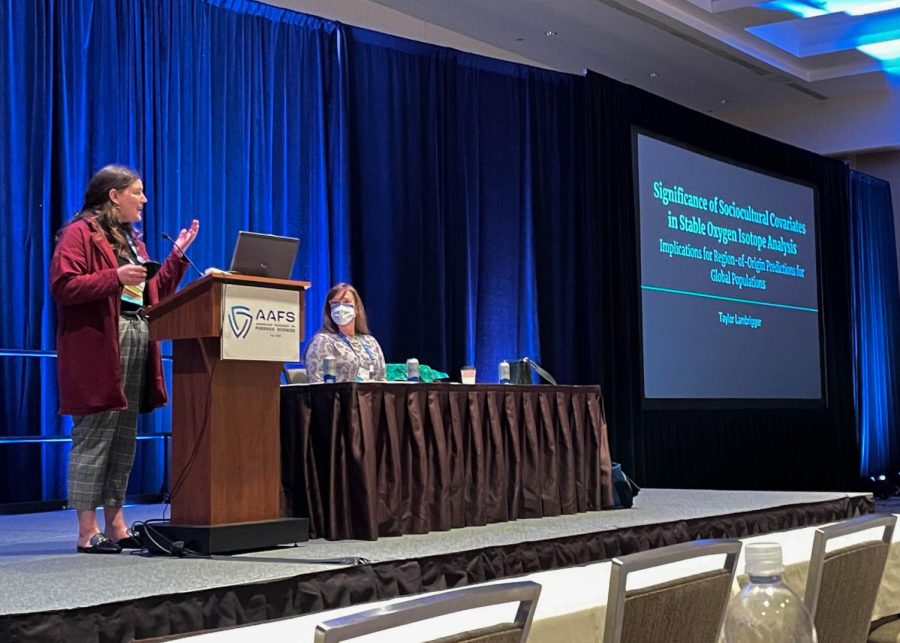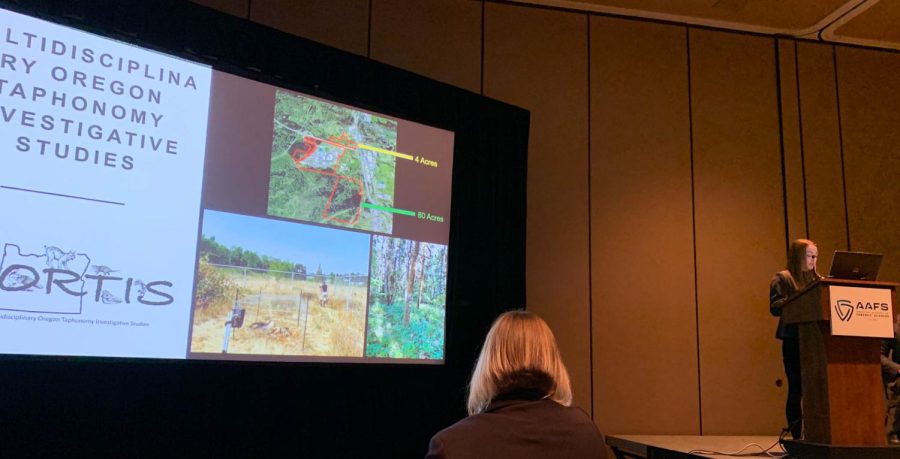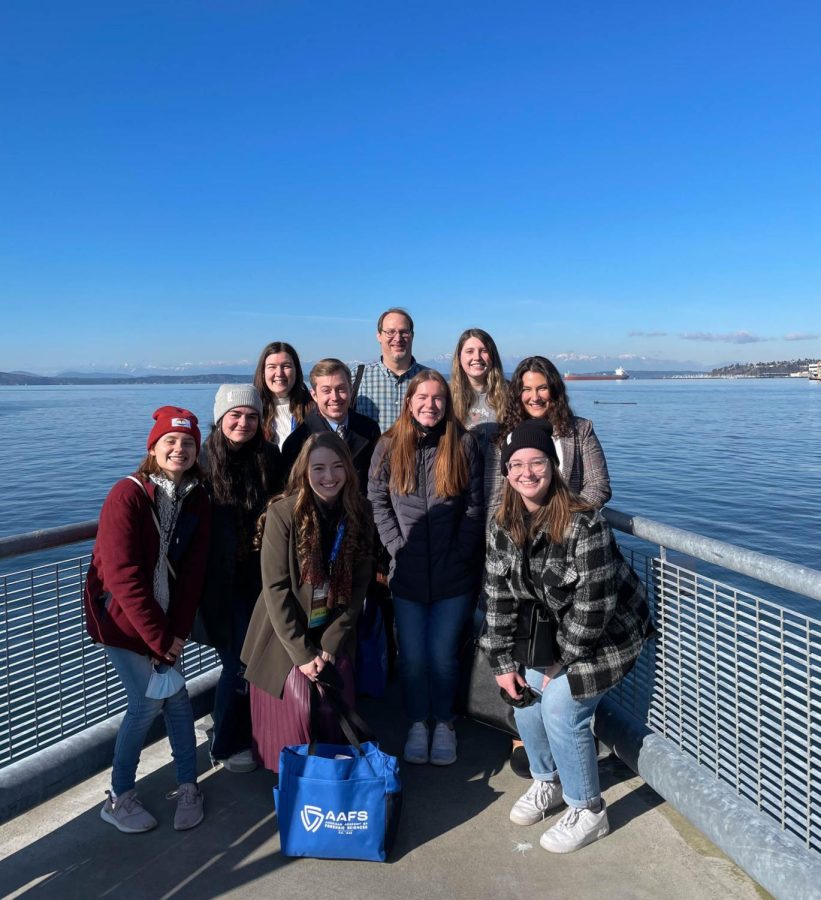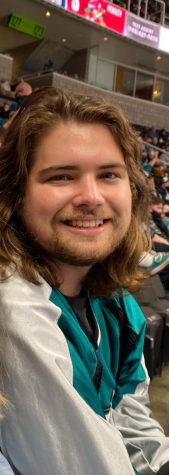This year the American Academy of Forensic Sciences hosted its 74th annual Scientific Conference, a national event that attracts some of the brightest minds in the field, including experienced forensic practitioners, forensic anthropologists and 11 Chico State students.
This year’s conference took place in Seattle from Feb. 21-25. Eleven students from Chico State’s Forensic Anthropology Program attended, three of whom were graduate students who presented at the conference: Cheyenne Collins, Thomas Delgado and Taylor Lambrigger.
Professor and faculty member Dr. Eric Bartelink was impressed with how the students performed.
“They all did great,” Bartelink said, “I thought they did a very professional job, top notch. They made us look good.”

Collins and Lambrigger felt confident about their respective presentations. Both presented research from their master’s theses.
Collins specializes in taphonomy, the study of what happens to remains after death until they’re discovered by forensic investigators. She had previously laid out six hog carcasses in western Oregon for the summer and recorded what happened. Her goal was to see how animal scavenging can differ among seasons in a particular region. In her presentation, she showcased over a year’s worth of research.

Lambrigger’s realm of expertise is in single isotope analysis, a topic she also presented on in 2019 at the AAFS conference in Baltimore. She completed her undergraduate studies at Northern Arizona University, where she worked on single isotope analysis, and worked with a medical examiner in Flagstaff, Arizona, to see if she could use her methods to help identify some decades-old remains they had on site.
This year Lambrigger’s presentation revolved around defending some of the research in her master’s thesis. She hopes her work can be used to help identify people who have died while trying to cross the U.S.-Mexico border.
The conference also included a symposium on queered science. Delgado presented during this symposium on the topic of necroviolence.
Despite presenting in front of more than 50 people, the students felt rather accomplished after the fact.

During the conference, the forensic anthropology students attended numerous presentations, many of which emphasized the importance of diversification. Lambrigger said it was nice to see the academy address the need for diversity in the field.
Bartelink presented twice. One presentation was on the value of master’s programs in training forensic anthropologists, and the other on the 20th anniversary of 9/11 and everything that the forensic anthropology community has since learned.
The conference recognized the accomplishments of individuals in the field and how far forensic anthropology has advanced. The anthropology section, one of 11 sections that belong to the Forensic Academy, celebrated the 50th anniversary of their section’s creation.
On the night of Feb. 24 the anthropology section held the Kerley Reception, named after Ellis Kerley, a pioneer in the field of forensic anthropology and the first member of the anthropology section to serve as head of the academy.
According to Collins, one purpose of the reception is to bring together many of the brightest minds in the field of forensic anthropology. The reception acts as an opportunity for fellow anthropologists to build new relationships.
“It’s one of the biggest opportunities for networking,” she said.
Each year the conference also awards accomplished practitioners. The Ellis Kerley award for best paper is one of the most prestigious and highly sought after awards in the field, one that Bartelink himself received in 2019.
The Kerley award is not the only award presented in the field, as Lambrigger received the J. Lawrence Angel award, an honor given for the best student paper presented at the conference.
Lambrigger says it’s opportunities like these, as well as the chance to work with the accomplished faculty that drew her to Chico State.
“We are fortunate that Chico is one of the, if not the best forensic anthropology program in the country for masters students,” Lambrigger said.
Chico State’s Forensic Anthropology Program currently has four board-certified anthropologists, and few programs offer this type of experience. The faculty include:
- Dr. Eric Bartelink
- Dr. Ashley Kendall
- Dr. Colleen Milligan
- Dr. P Willey, who has retired but still contributes frequently to case work
“The fact that we have three active forensic anthropologists is an anomaly, and we have a fourth one, Dr. P Willey, who is still practicing as well,” Lambrigger said, “That’s unheard of.”
On top of that, the program has even more enticing aspects.
Due to Chico’s unique placement in Northern California, and having one of the few graduate-level forensic anthropology programs on the West Coast, the university receives a multitude of cases.
Bartelink said Chico State students in the program are typically out in the field up to 25 days a year, and annually help conduct between 100-120 case analyses. When Collins was first deciding on where she wanted to go for graduate school, this is one of the things that attracted her to Chico State.
“The amount of case work and fieldwork that comes in, and the ability to learn from these individuals, doesn’t happen in a lot of other programs throughout the country,” Collins said. “It is one of the leading programs that students come to and I think it speaks to why we have such a diverse student population in the program as well.”
Noah Herbst can be reached at orionmanagingeditor.com or @NoahHerbst13 on Twitter.








